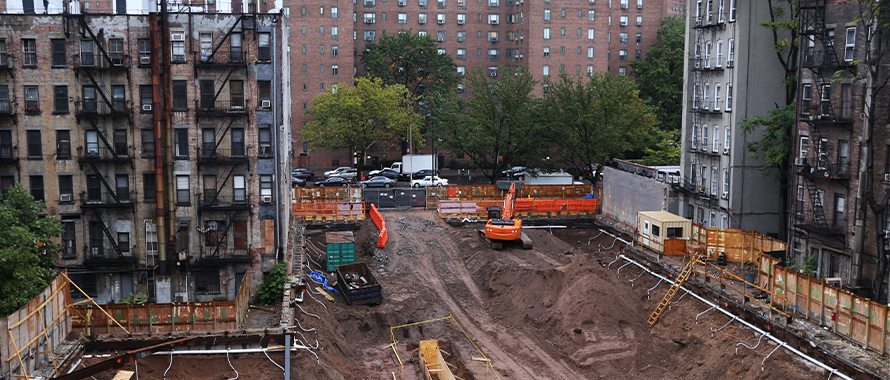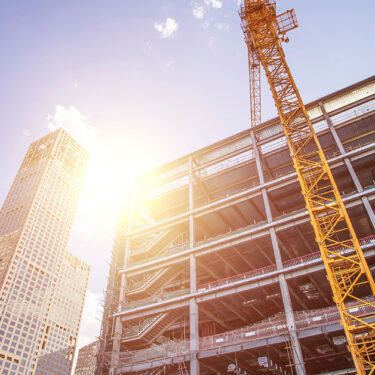A three-generation family in Brooklyn, New York, was recently evacuated from their home after city officials determined the building next door was unstable and would need to be demolished. The homeowner, Yvonne Belardo, was notified by firefighters on Sept. 5 that her three-story Bushwick home was at risk because of a construction error at a building site two doors down, where a contractor reportedly dug too deep, causing catastrophic damage to the home, CBS News New York reported.
Featured Solutions
“It is unfortunate,” said Kyle Lacertosa, Underwriter, Commercial Insurance, Burns & Wilcox, New York, New York. “We see these incidents occur all the time, and it is really out of the hands of the homeowner at this point. What they are trying to prevent here, though, is any injuries or fatalities from happening — because in the bigger picture of things, it could have been a lot worse.”
If there are structural issues in the neighboring locations, or families had to be evacuated because the homes are unlivable now, these are life-changing factors. … The amount of loss could be in the millions.
Nearby in the Fort Greene neighborhood, an error by a different contractor displaced residents in two buildings after the work caused a partial collapse of a load-bearing shared wall, CBS reported. The cost of the resulting damage to these homes and neighboring properties is likely to be “immense” and could be covered by a contractor’s Commercial General Liability (CGL) Insurance and Excess Liability Insurance, said Steven Hrab, Director, Construction, Burns & Wilcox, Toronto, Ontario.
“If there are structural issues in the neighboring locations, or families had to be evacuated because the homes are unlivable now, these are life-changing factors — and of course the cost of property in New York is astronomical,” Hrab said. “The amount of loss could be in the millions.”
Construction damage to neighboring properties not uncommon in dense areas
Increased building density across the U.S. underscores the importance of mitigating the risks of adjacent construction activities such as excavations, dewatering and drilling, Structure Magazine noted in a 2022 report on the issue. In Chinatown, Manhattan, earlier this year, property owners near a demolition site reported cracks showing up in their buildings and foundational cinder blocks shifting out of place, WABC reported in March. In September, residents of a neighborhood in Folsom, California, reported damage to their homes, vehicles and community clubhouse due to blast debris from construction at a new home development, KCRA reported.
More dense areas in Canada have also seen these incidents, including Toronto, Hrab said. In August, a two-story building in Toronto that appeared to be “leaning” toward the sidewalk was demolished and required adjoining units to be evacuated, displacing eight families, CBC News reported. The building was first deemed unsafe by the city in 2014 but an order to remedy it was left unresolved, the outlet reported.
By evacuating the building, what they are doing is trying to prevent injuries. Safety in construction is always the number one concern.
“We see this fairly frequently in more densely populated areas and older city centers where there are a lot of row houses, townhouses, and linked singles with shared foundations,” Hrab said, adding that these are properties where construction errors can cause a “chain reaction of damage.”
Structural damage due to adjacent construction often requires evacuating neighboring properties, Lacertosa said. “By evacuating the building, what they are doing is trying to prevent injuries,” he said. “Safety in construction is always the number one concern.”
When construction errors occur that lead to property damage or bodily injuries, the general contractor’s CGL Insurance can pick up costs including legal defense, settlements, and more. Although many parties may be pulled into a lawsuit, the general contractor who caused the damage is most likely to be held responsible, Hrab said.
“The owners may attempt to hold a lot of parties responsible. Ultimately, it will usually come down to the general contractor supervising the renovation work on the build site, as well as the actual contractors doing that specific work,” Hrab said, explaining that neighbors might first sue the property owner but that the owner’s insurance carrier would likely subrogate back to the contractor. “In a case like this, everybody will often be included in a lawsuit.”
While liability may ultimately fall to the contractor, multiple parties are commonly named in a lawsuit in these situations, Lacertosa agreed. “We can see a lot of individuals getting pulled into these claims,” he said. “That is why it is important to purchase a policy.”
Without insurance, property damage claim could bankrupt company
According to the San Mateo Daily Journal, construction on a new multipurpose room at a school in San Mateo, California, this summer led several neighbors to be concerned over potential damage to their homes. Some residents said they noticed cracks in their walls and driveways as well as doors that have shifted, the newspaper reported.
Given the potential for serious damage and even injuries, structural damage claims can be extremely costly. “Without a CGL Insurance policy in force, one job site could cause a million-dollar claim,” Lacertosa said. “There are also court costs, the cost to hire a lawyer, and the time involved — these court cases can take years and years. One claim could completely bankrupt a contractor without proper insurance.”
This type of lawsuit can also involve “a lot of moving parts,” Lacertosa said, and they often turn into full-limit losses of $1 million to $2 million or higher. Many CGL Insurance policies for contractors have limits of $1 million per occurrence and $2 million over the full policy period, making Excess Liability Insurance another essential policy for contractors.
“What we are seeing now is that additional limits often need to be put up. If a building collapses, that could be a $5 million claim. Without Excess Liability Insurance limits, you are bankrupt,” he said. “A smart, prudent contractor will carry additional limits to protect them in cases like this. If there is a fatality or a serious injury, there are millions and millions of dollars at stake. When you build a business, you do not want to leave it to chance.”
Without adequate insurance, a single accident — even one that is out of the contractor’s control — “can ruin everything overnight,” Lacertosa emphasized. “Accidents happen all the time,” he said.
Discuss policy limits, exclusions
A discussion about limits is important for general contractors, Hrab said. “For a general contractor supervising a build site, knowing that this is very niche work being done, we would want to ensure they have the highest level of liability limit so their CGL Insurance can respond,” he said. “Any kind of structural work requires very experienced individuals who should have a high liability limit on their CGL Insurance.”
According to CBS News, New York City’s Department of Buildings has been working to educate contractors and has recently noted a 32% reduction in stop-work orders.
Contractors who perform structural work or operate in large cities would need to discuss these activities with their insurance broker to ensure they are properly covered. Insurance carriers may “get very selective” about the types of contractors they will insure in these cases, Hrab said, and any subcontractors hired by the general contractor may also be required to carry insurance coverage. “We do require a level of experience to be doing this type of work because it can affect a number of adjoining locations and families,” he said.
Any kind of structural work requires very experienced individuals who should have a high liability limit on their CGL Insurance.
Common stipulations on CGL Insurance policies in this industry include residential exclusions, height exclusions, requirements for subcontractor insurance, and written hold-harmless agreements.
“One policy does not fit all,” Lacertosa explained. “Having a strong, knowledgeable wholesale broker is everything in the construction marketplace, especially for New York because the buildings and the foundations are so close together. Property damage is a huge, huge exposure.”
Professional Liability Insurance policies such as Architects & Engineers Insurance, or Errors & Omissions (E&O) Insurance, may also be needed in cases of damage due to construction errors, Lacertosa said. “There are many facets to consider, and there could be a professional aspect involved in these cases as well,” he said. “With a specialized insurance broker, you will know what policies you have for what exposures. There is not a one-size-fits-all for insurance.”
In addition, beyond the insurance considerations for general contractors, recent reports of damage due to adjacent construction activities may serve as a warning for homeowners to ensure they are covered by Homeowners Insurance, according to Hrab.
“These individuals who are out of a home and do not know what to do could potentially be uninsured or underinsured. It is so important for homeowners, whether or not they have a mortgage on their home, to keep a certain level of insurance,” he said. “If they do not have adequate insurance, where are they going to go after this? If they have a Homeowners Insurance policy on the adjoining property, the insurance would handle and subrogate. That would help these families be OK in the long run.”







